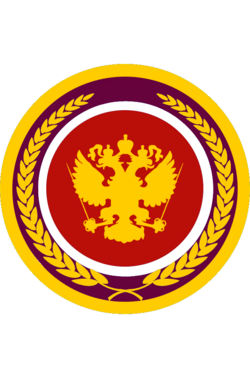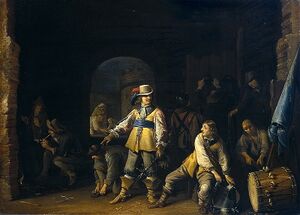Vithinjan Armed Forces
| Imperial Armed Forces of Aciria | |
|---|---|
| Forze Armate Imperiali di Aciria | |
 Crest of the Aciriani Armed Forces | |
| Founded | 7 July 1785 |
| Service branches | |
| Headquarters | Il Bastione, Aciria |
| Leadership | |
| Grand Emperor | |
| Head of Imperial Defense | |
| Marshal of Aciria | |
| Manpower | |
| Military age | 18 |
| Conscription | Yes |
| Active personnel | 562,000 |
| Reserve personnel | 2,705,000 |
| Expenditures | |
| Percent of GDP | 4.87% (2020) |
| Industry | |
| Domestic suppliers |
|
| Foreign suppliers | |
The Aciriani Armed Forces (Aciriano: Forze Armate Aciriano), formally known as the Imperial Armed Forces of Aciria, are the armed forces of Aciria. The armed forces are made up of four branches; the Imperial Army, the Imperial Navy, the Imperial Air Force, and the Imperial Administrative Police, which functions as an autonomous branch of the Imperial Army. Even if seldom used outside of the PAI, the armed forces have as much civilian jurisdiction within Aciria as the official police force. The armed forces are lead by the Head of Imperial Defense, who is appointed by and subordinate only to the Emperor of Aciria.
The Imperial Armed Forces were born from the ashes of the Free Republican Army following the reforms of Giovanni I in 1785, which established the Grand Army of the Empire. Due to the relative peace that has reigned in Aciria following the establishment of the empire, the army has been used mainly as a deterrent from foreign invasions, and to ensure domestic stability. The Second Great War is the most notable conflict the armed forces have taken a part in, which resulted in vast reforms in the ranks of the military after the war.
The mandatory conscription of every able-bodied man over the age of 18 has been in use since the Conscription Act of 1895. The armed forces have a unique place in Acirian culture due to its cultural and historical significance, alongside with providing citizens from lower classes a chance to rise in social status via a successful career in the military. The armed forces also has a notable influence on the economy of Aciria, due to the Acirian policy of self-sufficiency, aiming to develop and manufacture as much as possible of the equipment used by the armed forces within Aciria. Following the Second Great War, Caphiria slowly became the biggest, and eventually only foreign supplier of military equipment into Aciria.
History

The Imperial Armed Forces can trace their roots back to the Free Republican Army, established shortly after the declaration of the Free Republic of Aciria by Silvano de Albairate. Albairate's formation of the army was met with backlash from the People's Senate due to fears that it would be seen as a sign of aggression, but Albairate saw it necessary to ensure the sovereignty of the new republic. The initial army was formed from ethnic Aciriani legions and their supplies in the region, militias that sprouted up in the country in the unrest that followed the Acirian independence and volunteers from various social classes. Despite seeming like a capable fighting force, in reality the FRA would've likely been unable to fend off any major foreign invasions due to the corruption, insubordination and incompetence in its ranks, proven by the fact the FRA struggled to put down domestic revolts.
The FRA stayed in such a state until 1783 seized the throne of Aciria and declared the formation of the Empire of Aciria. With the Free Republic no longer existing, the Free Republic was quickly disbanded, its incompetent officers fired, corrupt officers rooted out by the PAI and reformed into the Grand Army of the Empire, the first branch of the Imperial Armed Forces. Because of the unrest spreading in the country, Giovanni was in a race against time to turn the army into a formidable fighting force. He invited foreign advisors, personally appointed the most capable officers and expanded arms trade from foreign nations to quickly modernize the armed forces, with its first test of ability being the Montanaro Uprising of 1803. Following the conflict, the conscription was scrapped due to worries of the quality of the troops suffering due to the amount of men the army had to manage.
Ranks
All branches of the Imperial Armed Forces share the same ranks, reason for this being that each branch was formed independently following the examples of the already existing branches.
Uniforms
Service branches
The Aciriani Armed Forces consists of the Imperial Army, Imperial Navy and Imperial Air Force. Additionally, the Imperial Administrative Police functions as a part of the Imperial Army.
Imperial Army
The Imperial Army of Aciria is by far the largest service branch of the Aciriani Armed Forces, boasting 432,000 personnel as of 2020. It is warranted by the mainly flat geography of Aciria to ensure numbers capable of both defending and reinforcing strategic points in Aciria as well as mount an eventual offensive assault. The Imperial Army is split into the defensive Citadel Army (Aciriano: Esercito della Cittadella), and the offensive Vanguard Army (Aciriano: Esercito d'Avanguardia), but the offensive army can adapt to defensive positions and vice versa. Since 2016, the Imperial Army has experienced rapid expansion of their tech-intensive elements, including but not limited to army aviation and various electronic warfare units. Outdated communications technology is in the process of being phased out for more recent, integrated information network.
The responsibilities which fall upon the Imperial Navy are naval and amphibious operations. With 70,000 men, including the 30,000 Imperial Marines, it is the second largest branch of the Imperial Armed Forces. The Imperial Navy consists of 200 commissioned ships, with the naval aviation force consisting of about 100 rotary-wing aircrafts.
The Imperial Navy includes the Imperial Fleet, Imperial Marines, and its headquarters located in Il Bastione alongside with the two other branches of the military. The highest ranking officer of the Imperial Navy is the Grand Admiral, whose responsibilities include the organization, recruitment, training, equipping, supply and the mobilization of the Imperial Navy.